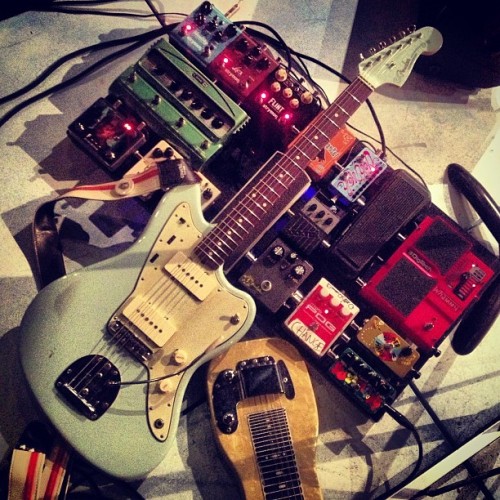
Inside of the rehearsal space, floating atop a sea of tangled cables, an object lies along the floor. It measures at about 40 inches long, 13 inches wide, and weighs an estimated 8.5 lbs (Shine). The artifact appears to be an amalgamation of natural and technological features: its anatomy is comprised of two central pieces of wood, with various other elements like metals and plastics intertwined into the surface of the structure. With even just a light tap, the object begins to vibrate, causing a whir of buzzy noise to fill the room. Though mostly unmarked, the top end boasts the words “FENDER” and “VINTAGE MODIFIED JAZZMASTER” which are etched deeply into it. This object, known as an electric guitar, has earned its place among the most unique instruments in history. Though it has existed for less than a century, the conditions surrounding its history and design yielded an artifact that would transcend genres, symbolize developing countercultures, and provide an entirely new approach to creation and expression.
In order to understand how this instrument has achieved such major cultural significance, one must first look to the intricacies of its design. Though invisible to the naked eye, the inner workings of the object house a great deal of complex wiring, similar to the guts inside of living organisms. In fact, when scanning from top to bottom, there are several parts of this object that seem to be a reflection of human anatomy. The guitar features a “neck” 22.5 inches in scale, along with a “head” comprised of a front bulb metal pegs along the back. Likewise, the “body” section comes complete with parts such an arm, a back, and a “belly”. The body is a structure that is rather unorthodox. Forming no conceivably recognizable shape, it can only be defined by one feature: it’s curves. Though technically amorphous, the buxom design is uncannily similar to the hourglass shape of a woman’s body. This is the first of many signs that this artifact that was purposefully constructed to be admired and desired. The sense of allure is also particularly noticeable when considering the smooth polyester finish: featured in colors such as “cherry red”, “ice blue”, and “butterscotch”, the artifact now appears more akin to a voluptuous piece of candy.

Additionally, there are characteristics of the instrument that embody aspects of nature. Once again, much like a human’s anatomy, the make of this object is naturally flawed. A close examination of the wooden neck reveals it to be slightly bowed and crooked. Just as the human spine is prone to lose alignment under the stress and pulls of everyday life, so does this Jazzmaster under the tension of 6 metallic strings, and intense bending of the tremolo arm. The power of sound is often referred to as having a certain kind of “energy” or giving of certain “vibrations”. By examining the neck of the guitar, it’s clear to see how. Scaling from the nut to the bridge, one may notice that the space between each of the frets becomes increasing smaller as one travels down towards the body. Compare this to textbook examples of energy vibrations and the electromagnetic spectrum, and a diagram of the power of sound waves becomes revealed right before one’s very eyes.


Perhaps one of the biggest indications of the cultural significance of this object lies in the unusual complexity of the history that surrounds it. Judging by the limited wear on the body, and the text “Vintage Modified Jazzmaster” along the headstock, the artifact at hand is not an original model, but a reissue of one from previous decades. The fact that this model continues to be reproduced certainly suggests that it sold well, but in reality, the instrument was virtually ignored at the time of its market introduction. In 1958, the guitar was first produced and released by the Fender Electric Guitar Company as an upscale version of their legendary Stratocaster model. Leo Fender conceptualized the instrument as a “deluxe” guitar, and marketed it as having a more “mellow” sound, specifically to suit the needs of jazz guitar players. However, the fate of the guitar would forever be changed as neither jazz enthusiasts nor the burgeoning rock-and-rollers seemed to be interested in it. From my own experience, I would argue that this is due in part to the Jazzmaster’s hyper resonant qualities, which produced significantly more feedback and white noise than the typical electric guitar of the period. The hi-gain, punchy sound was simply too raucous for the golden generation, who valued harmony and simplicity over energy.
Take, for example, this clip of the Everly Brothers performing their hit “All I Have to Do is Dream” from 1958. Arguably one of the defining songs of this era, the sound of an electric Stratocaster is present, but is placed far in the background while the gentle pluck of acoustics hold dominion. Despite Leo’s vision, the culture that the Jazzmaster was introduced to could not utilize the potential that the technology offered. It would take nearly another 20 years for the landscape of popular culture to catch up with this noisy, wooden object.
However, generational displacement of objects is no anomaly; in fact, it could be argued that many of the world most culturally resonant objects (musical ones in particular) do not find cultural adoption until years after their initial inception. For example, in her essay “Lucubrations on a Lava Lamp”, Jennifer Roberts supports this notion by examining the history of one of the paradigms of the 1960’s. Though the object would become espoused in the digs of the psychedelic counter-culture, the “Lava Lite” was initially intended as a mainstream house hold item, meant for dinner tables, the tops of television sets or as one ad even states, “…perfect for the study or den, so right for the executive suite” (Roberts). Much like the Lava Lamp, the make of a Jazzmaster was an unusual blend between the organic and the technological: it utilized the same standard technology and materials as any other electric guitar of the period, but the combination of a free-floating bridge, tremolo arm, and single-coil electromagnetic pickups created a sound that was too discordant to be adopted by popular culture, and too early for the developing counter culture to be able to embrace it (Audiofanzine).
The Jazzmaster was certainly not the first popular guitar to be met with initial rejection. In fact, across the 84 years since the electric guitars inception, there have been at least 4 major shifts of preferences in body style and sound, each accompanying the evolution of trends in popular culture. For each one of these shifts in sound, the industry’s answer has always been a model that was introduced in previous years, but faced initial rejection by players and listeners alike. In order to understand how a commercially rejected guitar could eventually become a godsend for generations worth of underground musicians, one must first understand the musical climates that preceded it.
The first era spans from 1931 to 1963, beginning with Adolph Rickenbacker’s invention of the electromagnetic pickup, and ending with the rise of the British Invasion. This period emphasized smoother, non-invasive guitar sounds with minimal distortion. This clip of Elvis and his backing band embodies all of these characteristics, both visually and sonically. The featured guitar here is a 1950’s Gretsch archtop, a staple among players of this era. This model has an unusually wide, hollow-body with Filter’Tron style pickups to achieve a sound more akin to an acoustic instrument. It should be noted that in this footage, the electric guitar’s sound is buried in the background, as the piano remains the primary focus behind Elvis’ voice. This is rather unusual, considering that the inspiration behind creating the electromagnetic pickup was to allow the guitar a chance to be heard above other instruments. The fact that its sound remained so constrained during this era reveals much about the fears performers and music producers had about the power of this newfangled technology. In a culture that embraced large size and minimal volume, it’s clear to see how the sleek and noisy Jazzmaster model would fail to resonate within the market.
The second shift of electric guitars spanned from around 1963 to 1970, as British players and American copy-cats chimed in a new generation of exciting and expansive sounds. Juxtaposed to the muted, low end plucks found on early pop and rockabilly records, the era of the 1960’s heralded in a new emphasis on bright, trebly guitar tones. The epitome of this generation of rock music was without a doubt the German-made Rickenbacker guitar models, are famous for the sparkling, jangly sounds that would become synonymous with the music of 1960’s culture. In fact, much like the Jazzmaster, the Rickenbacker Capri series was unveiled in 1958, and was also initially met with confusion in the commercial market. However, unlike the Fender product, the Rickenbacker models would gain widespread appeal at a much quicker pace, as the company began branding itself as the “Beatle-backer” because of John Lennon and George Harrison’s extensive use of their guitars, especially during the fab-four’s formative years. In addition to rock and roll music, this brand was also responsible for ushering in folk music into popular culture, which used its sparkling tone to refresh their classical songwriter arrangements. In this period, the Jazzmaster would see a brief stint in popularity, due to its role in the short-lived surf music craze, but this wave of success was only temporary (Wolk). Once again, the sound was deemed too harsh to have a place in pop music, but the first signs of a significant alternative music movement was beginning to take formation.
But before the Jazzmaster would eventually be adopted amongst mainstream culture, it was the Les Paul electric guitar model that would be the voice of early 70’s guitar players. What little footing the Jazzmaster had gained in the 1960’s was inevitably lost because of a new emphasis on a “fat” guitar tone with longer sustain. The Les Paul was introduced by Gibson in 1952, and once again rose to universal acclaim despite a long period of lukewarm receptions. The success of the instrument is due largely to the sound of its duel humbucker pickups, responsible for creating the wide and powerful guitar tones that would be adopted by musicians such as Peter Frampton, Mick Ronson, and Jimmy Page. As a result, the “retro” look and sound of the Fender Jazzmaster was once again scoffed at by most musicians of this era, and production of the instrument ceased around 1976.

While two decades worth of commercial failure typically marks the inadequacy of a product, in hindsight, the Jazzmaster’s long incubation period was essential to fulfilling its fateful role within underground rock culture. As production began to wind down, hundreds of Jazzmasters began to appear along the walls of pawnshops and discount music stores all throughout the world. However, this also meant that new, high-end electric guitars could be purchased at low prices, thus opening up the door for many musicians who may have been unable to purchase such an instrument otherwise. Just around the end of the Jazzmaster’s first production, cult heroes such as Tom Verlaine (of Television) and Elvis Costello began acquiring guitars from pawnshops, and used them in marking their unique images and sound. Notably, Costello used his Jazzmaster as a centerpiece of his 1977 debut “My Aim is True”, including on the front and back cover art. The guitar, which he claims he “never knew even existed” until his bargain-bin discovery, became crucial to creating the sharp, “spy movie” pluck on his early hits such as “Watching the Detectives” and “(I Don’t Want to Go to) Chelsea”. Much like the archtops, Rickenbackers, and Les Paul models, the previously ignored Fender instrument would finally begin to build a relationship with an emerging generation of musicians.
By the 1980’s the Jazzmaster had become a cult phenomenon, playing a major part in the sound of the developing “art rock” and American “indie rock” scenes. In particular, members of Sonic Youth formed a deep connection with the guitar model, as the hyper-resonant qualities that were deemed inappropriate for previous generations were now perfectly suited for the discordant alternative movement. Because they were so easily replaced, Sonic Youth hoarded dozens of these pawnshop treasures: their inexpensive price tag created the opportunity to bands to conduct extensive experimentations, including unorthodox modifications and new techniques such as bashing them with drum sticks, or recording the destruction of the instrument. Just a few years later, the guitar would become a staple in the arsenal of timeless pop bands such as The Cure and The Smiths. Much like the Lava Lamps of Robert’s essay, this object may have been invented by one generation, but it was destined to become synonymous with another.
What made (and still makes) the Jazzmaster truly stand apart is that the combination of its history, versatility, and flaws have crafted it into one of the few object that provides the player with total control, producing an entirely new range of potential expression. The greatest testament to this statement comes from the work of Kevin Shields, guitar player for the Irish rock group My Bloody Valentine. Between the 1988 and 1991, Shields transcended musical charts, and created entirely new genres of music by taking the style of his peers and adding onto it with open tunings and using the tremolo arm to excessively manipulate pitch. The result was a whirling and warped sound known as “Glide guitar”, which creates dense, highly texturized soundscapes. According to Shields, when being played at extreme volumes, Glide guitar can reportedly influence brainwaves, and puts the listener in a trance-like state(BBC FOUR).
Shields claims to owe his success entirely to the “constant feeling of expression” provided by the Fender Jazzmaster, and he’s not wrong for doing so. Once again returning to its anatomy, there are several key features responsible for crafting this otherworldly sound. Firstly, the combination of the free-floating bridge with the natural imperfections of its wooden body results in an unusually high amount of string resonance along the object’s neck. The overtones created by this resonance have a sound akin to eastern instruments such as a sitar or a tanpura. The sound is incredibly organic, as the vibrations create a natural motion which wanes and waxes, even when droning on a single note. When the motion of the resonant strings is met with a bending tremolo arm, the resulting sound waves are highly texturized and possess a circadian kind of rhythm that is not easily replicated otherwise. As stated previously, all guitars create vibrations, but the characteristics of the Jazzmaster take these energy waves, and manipulate them with massive swells and oscillating tonality to a dizzying, psychedelic effect.
Despite its unparalleled features, the Jazzmaster spent much of its life being misunderstood and dismissed by the company and the culture that reared it. But in this period, stuffed among the pawnshop clutter, the guitar would take on a second life, and evolve into a symbol for change and musical innovation. As if by fate, the Fender model became a physical representation of the repudiation facing the underground rockers who wielded them.By the 21st century, the Jazzmaster made a triumphant return to the market, and has remained there to this day. In his book “Loveless”, author Mike McGonigal shares that he, among others, see glide guitar style is “the pinnacle of guitar music”, and yet to be surpassed (McGonigal). While it may be unclear how time and technology will alter the musical climate, it appears that an object once written off by its culture may also be the one to have the last laugh.
A fitting accomplishment for Fender’s greatest problem child.
References:
“Fender Classic Player Jazzmaster & Jaguar: The Test.” Audiofanzine. N.p., n.d. Web. 04 Dec. 2014.”
“McGonigal, Mike. Loveless. New York: Continuum, 2007. Print.”
“Prown, Jules David., Kenneth Haltman, and Jennifer L. Roberts. American Artifacts: Essays in Material Culture. East Lansing: Michigan State UP, 2000. Print.”
“Shine, James W., Jr. “The Intricacies of the Fender Jazzmaster.” N.p., 3 Jan. 2005. Web. 07 Oct. 2014.”
“The Joy of the Guitar Riff. Perf. Kevin Shields. BBC, 2014. BBC Four. Web. 07 Oct. 2014.”
“Wolk, Douglas. “The Fender Jazzmaster’s Story, From the Fireballs to Lee Ranaldo.”





